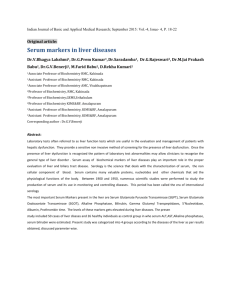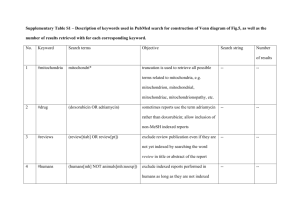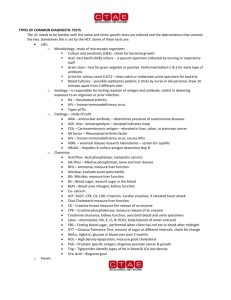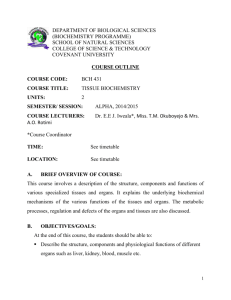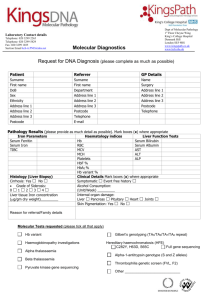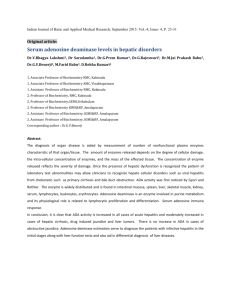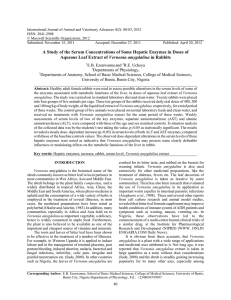serum biochemistry - Alpine Animal Hospital
advertisement
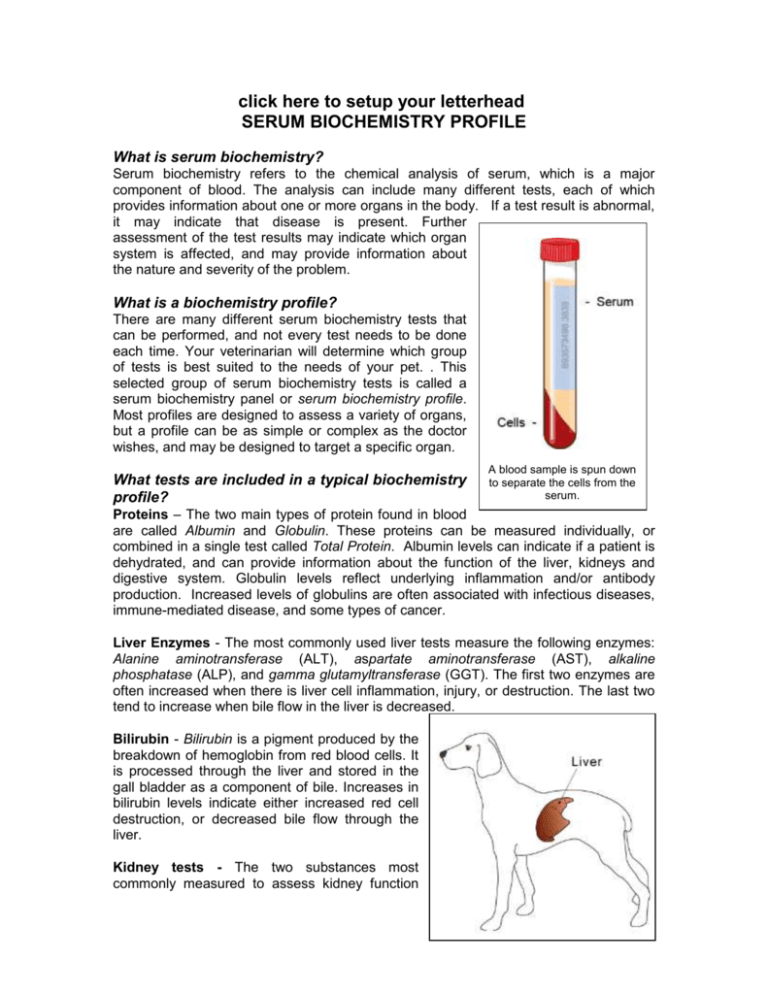
click here to setup your letterhead SERUM BIOCHEMISTRY PROFILE What is serum biochemistry? Serum biochemistry refers to the chemical analysis of serum, which is a major component of blood. The analysis can include many different tests, each of which provides information about one or more organs in the body. If a test result is abnormal, it may indicate that disease is present. Further assessment of the test results may indicate which organ system is affected, and may provide information about the nature and severity of the problem. What is a biochemistry profile? There are many different serum biochemistry tests that can be performed, and not every test needs to be done each time. Your veterinarian will determine which group of tests is best suited to the needs of your pet. . This selected group of serum biochemistry tests is called a serum biochemistry panel or serum biochemistry profile. Most profiles are designed to assess a variety of organs, but a profile can be as simple or complex as the doctor wishes, and may be designed to target a specific organ. What tests are included in a typical biochemistry profile? A blood sample is spun down to separate the cells from the serum. Proteins – The two main types of protein found in blood are called Albumin and Globulin. These proteins can be measured individually, or combined in a single test called Total Protein. Albumin levels can indicate if a patient is dehydrated, and can provide information about the function of the liver, kidneys and digestive system. Globulin levels reflect underlying inflammation and/or antibody production. Increased levels of globulins are often associated with infectious diseases, immune-mediated disease, and some types of cancer. Liver Enzymes - The most commonly used liver tests measure the following enzymes: Alanine aminotransferase (ALT), aspartate aminotransferase (AST), alkaline phosphatase (ALP), and gamma glutamyltransferase (GGT). The first two enzymes are often increased when there is liver cell inflammation, injury, or destruction. The last two tend to increase when bile flow in the liver is decreased. Bilirubin - Bilirubin is a pigment produced by the breakdown of hemoglobin from red blood cells. It is processed through the liver and stored in the gall bladder as a component of bile. Increases in bilirubin levels indicate either increased red cell destruction, or decreased bile flow through the liver. Kidney tests - The two substances most commonly measured to assess kidney function are Urea (also called blood urea nitrogen or BUN) and Creatinine. Urea is a by-product of protein breakdown; it is produced in the liver and excreted from the body in urine. Increases in BUN may indicate dehydration, gastrointestinal bleeding, or kidney disease. Decreases in BUN are associated with overhydration , liver failure, or kidney disease. Creatinine is a by-product of muscle metabolism. Increased levels of creatinine indicate decreased kidney function. Pancreatic Enzymes - The most commonly measured pancreatic enzymes are Amylase and Lipase. Increases in these enzymes are often found when the pancreas is inflamed, although they can also be elevated when there is kidney or intestinal disease, and when certain drugs are used. Glucose - The sugar found in blood is called Glucose. Persistently elevated blood glucose is typically associated with diabetes mellitus, also called "sugar diabetes". In the cat, stress can cause a temporary rise in blood sugar that can be difficult to differentiate from diabetes. Low blood sugar is associated with some types of tumors and bacterial infections, or with insulin overdose in diabetic patients. Low blood sugar can also be found in newborn animals, some very small breeds of dogs, and high performance dogs that exercise extensively, such as hunting dogs. Calcium and Phosphorus - These minerals are present in tiny amounts in blood, and changes, either up or down, may indicate underlying disease. Persistently high calcium levels may indicate the presence of cancer, or disease of the parathyroid glands, while low calcium levels may cause convulsions. High phosphorus levels are associated with kidney failure, and some nutritional problems. Muscle Enzymes - The enzyme most frequently measured to assess muscle health is Creatine Kinase. Of lesser importance are the enzymes Aspartate aminotransferase (AST) and Alanine aminotransferase (ALT), which are also used to assess liver function. Elevations in muscle enzymes are often found with muscular activity (exercise, exertion, convulsions etc.), trauma, and muscle inflammation. Cholesterol - Cholesterol is produced in the liver as part of fat metabolism. Increases in cholesterol are associated with hormonal and metabolic diseases, liver disease, and serious kidney disease. Electrolytes - The most important electrolytes are: Potassium, Chloride, Sodium, and Bicarbonate. These substances are present in blood in small quantities, and each electrolyte has a different role to play in the body. Collectively, electrolytes help to maintain blood and tissue fluids in a stable and balanced state. Disturbances in electrolytes are often caused by vomiting and/or diarrhea, and are encountered with many serious metabolic diseases. This client information sheet is based on material written by Kristiina Ruotsalo, DVM, DVSc, Dip ACVP & Margo S. Tant BSc, DVM, DVSc. © Copyright 2004 Lifelearn Inc. Used with permission under license. February 15, 2016
